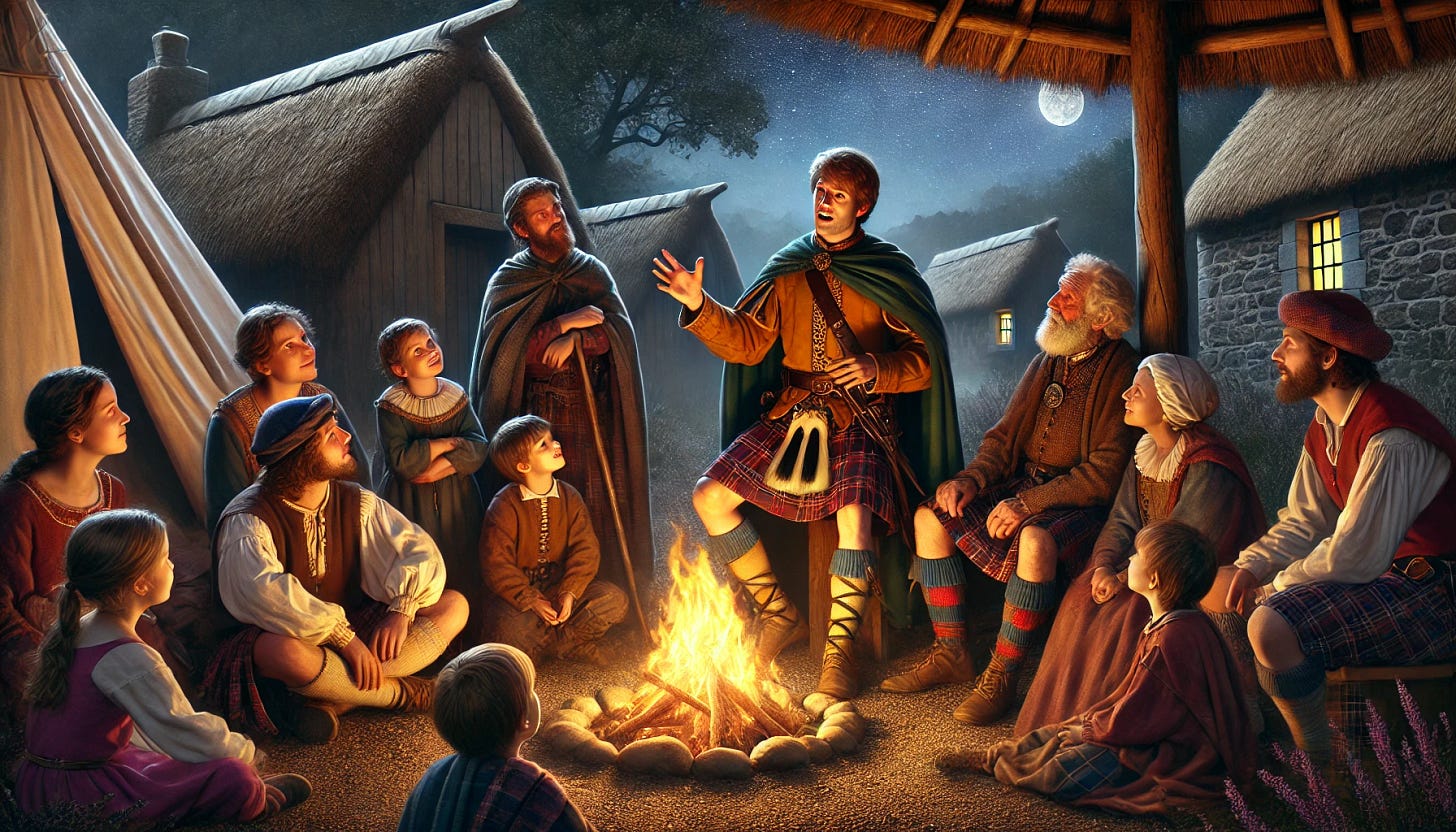The Art of Storytelling in Medieval Scotland
Storytelling in medieval Scotland was a rich and vital tradition, weaving together history, culture, and mythology to create a tapestry of narratives that shaped the identity and values of its people. Among these stories, the legend of the Horseman and the Serpent of Linton stands out, not just for its drama and heroism, but for what it reveals about the art of storytelling during this era.
The Power of Oral Tradition
In medieval Scotland, the art of storytelling was primarily oral. Tales were passed down from generation to generation by word of mouth, a practice that ensured their survival even in the absence of written records. This oral tradition was the bedrock of Scottish cultural heritage, with bards and storytellers playing a crucial role in preserving the collective memory of communities.
These storytellers, known as seanchaí in Gaelic, were highly respected figures. They were the keepers of history, genealogy, and lore, using their talents to entertain, educate, and inspire. Their performances were often held in communal spaces such as halls and around campfires, where listeners of all ages would gather to hear tales of heroes, battles, and supernatural beings.
The Structure of Medieval Scottish Tales
Medieval Scottish stories often followed a structure that made them easy to remember and retell. They typically featured a clear beginning, middle, and end, with a focus on dramatic and moral elements. Characters were vividly drawn, with heroes exemplifying virtues such as bravery, loyalty, and honor, while villains embodied traits like treachery and greed.
The legend of the Serpent of Linton, for example, follows a classic narrative arc. It begins with the introduction of a monstrous threat, the serpent, which terrorizes the community. The hero, Sir John Somerville, emerges to confront this danger, and through a combination of courage, intelligence, and preparation, he triumphs over the beast. The story concludes with the community’s relief and the hero’s reward, reinforcing the values of bravery and justice.
Themes and Symbolism
Scottish medieval stories were rich in themes and symbolism, often reflecting the societal values and concerns of the time. Common themes included the struggle between good and evil, the importance of kinship and loyalty, and the hero's journey—a quest that tested the protagonist's mettle and often involved supernatural challenges.
In the tale of the Serpent of Linton, the serpent symbolizes chaos and fear, while Sir John Somerville represents order and courage. The hero’s victory over the beast is not just a literal triumph but also a symbolic restoration of balance and peace in the community. Such stories served to reinforce social norms and inspire listeners to emulate the virtues displayed by the heroes.
The Evolution of Stories
As stories were told and retold, they evolved. Each storyteller might add their embellishments, tailoring the narrative to suit their audience or to highlight particular moral lessons. This evolution kept the stories dynamic and relevant, allowing them to adapt to changing times while retaining their core messages.
For instance, while the basic elements of the Serpent of Linton tale remain consistent, variations in the details reflect the creative input of different storytellers. Some versions might emphasize the supernatural aspects of the serpent, while others focus on the hero’s ingenuity and bravery. This flexibility ensured that the stories resonated with successive generations.
The Role of Storytelling in Community and Identity
Storytelling was more than just entertainment; it was a way of building and maintaining community. Through shared stories, people forged a common identity and a sense of belonging. The tales connected listeners to their past, offering a sense of continuity and stability.
In medieval Scotland, where written records were scarce, storytelling was a vital means of preserving history. Legends like that of the Serpent of Linton served as mnemonic devices, helping communities remember significant events and figures. They also provided a way to pass on cultural values and social norms, ensuring that these were upheld by future generations.
The Legacy of Medieval Scottish Storytelling
The legacy of medieval Scottish storytelling endures today. Many of the tales from this period have been written down and studied, becoming an integral part of Scotland’s literary heritage. Festivals, reenactments, and modern storytelling sessions continue to celebrate this rich tradition, keeping the spirit of the old seanchaí alive.
The legend of the Horseman and the Serpent of Linton, like many other medieval stories, offers a glimpse into the past—a time when storytelling was a central part of life. It reminds us of the power of narrative to shape our understanding of the world and to connect us with our cultural roots.
Conclusion
The art of storytelling in medieval Scotland was a profound and multifaceted tradition that played a crucial role in shaping the identity and values of its people. Through tales like the Serpent of Linton, we see how stories were used to entertain, educate, and inspire, reflecting the themes and concerns of their time. As we continue to explore and celebrate these narratives, we keep alive a vital part of Scotland’s cultural heritage, honoring the legacy of the storytellers who once wove these tales by the flickering light of a communal fire.





